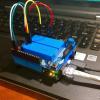
Best Answer Mario Vernari, 06 February 2013 - 04:19 PM
The 70'C is just a nominal-standard "warranty" bound. If you run your board at 69'C or 71'C won't change anything.
BTW, your Netduino should run pretty decently even above 100'C, but -of course- no manufacturer yields you guarantee on the reliability, nor Chris Walker!
What happens if you take the Netduino up to (e.g.) +125'C for a "long time" (e.g. days)?
The heating shakes a lot more the electrons, and that's for "any" electron! For instance, since the flash is able to store a bit value by "trapping" a bunch of electrons inside an insulated particle of metal, the more the electrons will be shaked, the higher will be the probability they're able to "jump off" the island. It's much like many horses: when they're agitated, someone could jump off its bound and escape. When the number of electrons still is the island is too low, the bit value could be read as "uncertain". This equals to a data losing.
So, the "70'C" is a logical threshold above which the warranty voids. The probability to lose data is always presente, but -of course- is lesser when the temperature is low.
The silicon begins to deteriorate above 150-200 'C (for many seconds).
It is a pretty complex discussion behind this limit:, the duration and the "point" at where the temp is referred is also very important.
@Dave. Your idea might be nice for steep temperature variations, but when is stable, the oil can't do anything.
Cheers.
Go to the full post
















